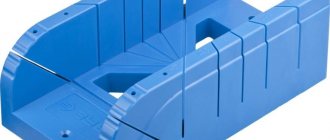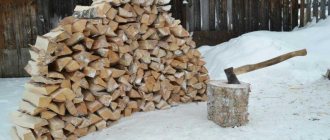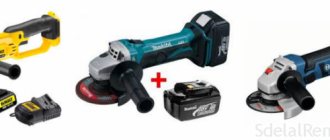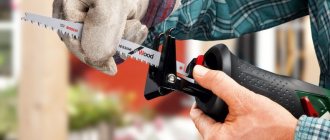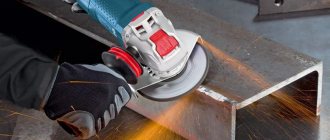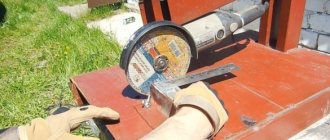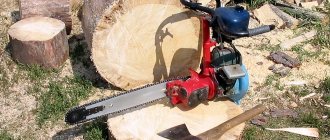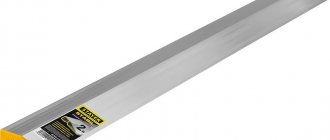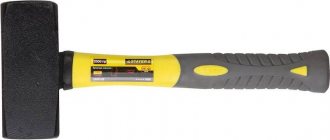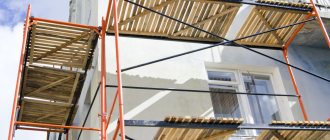Cutting siding correctly is easy. Finishing the facade and basement of a house with siding has become very popular and in demand in recent years. Siding panels must be cut if a smaller width or length of the finishing material is required. Therefore, it is very important to know how to cut siding correctly and as easily as possible. Currently, domestic and foreign manufacturers offer a fairly wide range of manufactured tools that are optimally suited for cutting both metal and vinyl siding.
Cutting metal siding
Metal siding panels are produced by cold rolling from galvanized steel or aluminum and can have different types of coatings. This material has many advantages, including absolute non-flammability, due to which it has found wide application in exterior decoration.
Metal siding is most often cut with professional tools that do not leave nicks that lead to corrosive changes on the panels. In summer, it is allowed to use a hacksaw or metal scissors for cutting. At any time of the year, it is best to use a circular electric saw, which makes the most even cut, or a hand-held circular saw equipped with pobedit teeth. It is not recommended to use an angle grinder with an abrasive wheel, which leads to heating of the metal.
The best way to cut metal siding is to use a circular saw.
Cutting plastic siding
Vinyl, or plastic, siding is made from thermoplastic synthetic materials, which makes its cutting very specific. Most often, manufacturers of such finishing materials recommend cutting panels using a jigsaw. Such a construction tool has indeed proven itself well when cutting plastic, but the cutting blade must have fine teeth. However, the easiest way to cut siding is to use a standard grinder, known to many as an angle grinder, as a cutting tool. If such tools are not available, you can use a hand saw or metal scissors, as well as a sharpened shoe knife.
It is recommended to cut vinyl siding with a jigsaw
Tool overview
Now it's time to get acquainted with the features of the tools. Manufacturers offer cutting with tools such as a power saw, jigsaw, hacksaw, scissors, knife and everyone’s favorite “grinder”.
Electric saw
Many siding manufacturers recommend that their consumers cut siding using a fine-tooth saw.
This recommendation carries with it a number of negative aspects:
- Firstly, a fairly small number of manufacturers have this type of saw. The world-famous Bosch, for example, does not have it at all, despite the fact that it is one of the leaders in this field. As a result, consumers have a search problem.
Working with such a massive tool requires certain skills, remember this
- Secondly, even if a person finds such a saw, it will be quite difficult to make a cut with it. Simply put, such a tool is only suitable for an experienced specialist.
- Thirdly, with its help it is almost impossible to make end cuts. As a result, a person will have to purchase an additional tool to perform this operation. The question arises, why use a saw at all?
- Finally, the last point worth noting is the fact that only a professional will be able to notice inaccuracies during the cutting process. This is due to the fact that the person doing the cutting practically does not see how it is done, since the support platform blocks the view. This jeopardizes the success of the entire operation.
READ ALSO: Advice from practitioners: which siding to choose for finishing a house It
looks extremely strange that the instructions of most siding manufacturers recommend cutting using an electric saw.
The naked eye can see that this tool is hardly suitable for performing this operation. Some companies will post various images in which even an inexperienced saw can be used without any problems. Using a jigsaw can be done using a saw, but this is only in the picture.
Jigsaw
Familiar to many from labor lessons in school, a jigsaw can also be used to cut siding.
However, it is worth clarifying several important points:
- Even an inexperienced craftsman can handle using a jigsaw.
Before cutting metal siding, you need to prepare a support. Siding panels are not a strong material, so when pressure is applied they will begin to seriously sag. It is recommended to build a support from wooden blocks. - It is extremely difficult to cut out a small piece of material using a jigsaw. This is due to the fact that during the cutting process it begins to vibrate seriously, compromising the accuracy of the operation.
- Surprisingly, only a few manufacturers make public in their instructions the fact that siding can only be cut with a jigsaw with a T101 blade. The key purpose of this blade is cutting laminate. Do not under any circumstances try to cut the panels with a cloth of a different size, as they will inevitably break.
When working with a jigsaw, keep a distance of 30-40 cm from it to avoid metal shavings getting on your face and clothes.
A jigsaw with the recommended blade size can quite easily make both transverse and longitudinal cuts. But with cutouts at the ends, this tool will absolutely not be able to cope. One more nuance - when using a jigsaw, the cut turns out to be substantially torn, so this tool can only be used in good warm weather.
Hacksaw for metal
When using a hacksaw, wear gloves to prevent injury.
Almost all manufacturers unanimously say that with a hacksaw you can cut siding in any weather, while giving it the desired shape. However, in reality this turns out to be not a completely objective assessment.
In particular, with its help it is almost impossible to make a transverse incision. This is due to the fact that the working length is not enough to perform this operation. However, if you show some skill, it is still possible to accomplish the task.
Advice: stock up on several replacement blades, as they become dull rather quickly from PVC.
It is very important to choose a suitable blade.
As for carving at an angle, it is basically impossible to do this with a hacksaw. The same applies to cutting soffits. As a result, it can be stated that this tool is suitable only for a limited scope of work.
Metal scissors
It is very important to know that you can only cut siding with scissors in warm weather, since at low temperatures the material will begin to seriously crack. However, some models of scissors can give this effect in any weather, so it is very important to choose them responsibly.
Tip: before cutting, carefully sharpen the scissors using a special sharpener.
It is also worth understanding the following points:
- When cutting with scissors, do not completely close their ends, as this will damage the material.
- It is recommended to start cutting from the upper edges on which the fastening part is located. However, such a measure leads to the fact that a person will make more efforts. In addition, having reached the top edge, the movement of the edges of the scissors will be extremely difficult to stop.
In practice, it turns out that to stop the movement of the edges of the scissors, you either need to practice for a very long time, or have considerable physical strength. However, there is an easier way out of this situation - start cutting the siding from the bottom side, contrary to the recommendations.
Today, there are semi-automatic models of scissors that greatly simplify the cutting process.
An inexperienced craftsman may inevitably encounter the fact that, as a result of certain cutting efforts, the siding will begin to crumple, and if the work is carried out at relatively low temperatures, it will crack. If you have not worked with metal scissors, watch the instructional video at the end of this article, which will help you understand the basics. However, it is better to practice before starting cutting; for this you can use a small piece of panel.
Construction knife
Perhaps the most commonplace tool for performing this operation is a knife. Almost anyone can handle it. However, does it guarantee cutting accuracy?
The knife should have a “floating” roller, as in this photo. It has a shock-absorbing effect
As practice shows, it is quite possible to make a precise cut with a knife and you do not need to have special skills for this. The main thing is that it is well sharpened.
Cutting should be done as follows:
- A mark is made along the line of the intended cut using a pencil.
- Following the marking, a straight furrow is drawn with a knife.
- The panel is bent several times until it breaks into two parts.
Using this method you can easily cut straight sections. When it comes to corner elements (for example, window frames), you have to apply a little more effort.
In particular, you will first need to make two transverse cuts, then apply a ruler to them and make a long cut, then bend the element to be cut and it will break off easily.
Thus, it can be stated that the knife is quite a competitive tool for cutting siding. The main thing is to make every effort and know some tricks.
Bulgarian
Almost all siding manufacturers claim that the grinder can damage the material, therefore, its use is inappropriate. According to them, during the cutting process the material will begin to seriously crack. However, is this really so?
When cutting with a grinder, it is very important to hold the panel
Contrary to prevailing stereotypes, some people still decide to use an angle grinder. To the surprise of many, such a tool does not carry destructive power, but on the contrary, allows you to achieve amazing evenness.
The main thing is to understand a few important points.
- It is worth working at low or medium speeds, since at high speeds there is a high risk of deformation of the panels.
- It is best to use medium power models, that is, 1000 - 1400 W. However, you can use less powerful analogues.
- It is important to pay attention to protecting the device from dust. In particular, it is necessary to equip the instrument with a special membrane. Metal dust can harm the angle grinder if it gets into the engine.
- Use only a thin disc (within 100-125 mm diameter and 1.5-2 mm thickness). More impressive models can seriously damage the surface. In addition, they do not provide high accuracy.
- Pay special attention to the bead cut in the upper part, since during execution you need to stop the tool in time. If you don't do this, you can cut through the entire panel. For insurance, you can ask your partner to follow the movement of the car.

